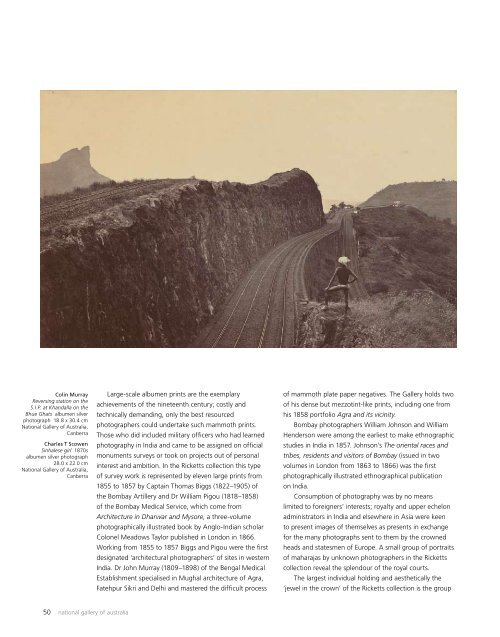Art Ew - National Gallery of Australia
Art Ew - National Gallery of Australia
Art Ew - National Gallery of Australia
You also want an ePaper? Increase the reach of your titles
YUMPU automatically turns print PDFs into web optimized ePapers that Google loves.
Colin Murray<br />
Reversing station on the<br />
S.I.P. at Khandalla on the<br />
Bhue Ghats albumen silver<br />
photograph 18.8 x 30.4 cm<br />
<strong>National</strong> <strong>Gallery</strong> <strong>of</strong> <strong>Australia</strong>,<br />
Canberra<br />
Charles T Scowen<br />
Sinhalese girl 1870s<br />
albumen silver photograph<br />
28.0 x 22.0 cm<br />
<strong>National</strong> <strong>Gallery</strong> <strong>of</strong> <strong>Australia</strong>,<br />
Canberra<br />
50 national gallery <strong>of</strong> australia<br />
Large-scale albumen prints are the exemplary<br />
achievements <strong>of</strong> the nineteenth century; costly and<br />
technically demanding, only the best resourced<br />
photographers could undertake such mammoth prints.<br />
Those who did included military <strong>of</strong>ficers who had learned<br />
photography in India and came to be assigned on <strong>of</strong>ficial<br />
monuments surveys or took on projects out <strong>of</strong> personal<br />
interest and ambition. In the Ricketts collection this type<br />
<strong>of</strong> survey work is represented by eleven large prints from<br />
1855 to 1857 by Captain Thomas Biggs (1822–1905) <strong>of</strong><br />
the Bombay <strong>Art</strong>illery and Dr William Pigou (1818–1858)<br />
<strong>of</strong> the Bombay Medical Service, which come from<br />
Architecture in Dharwar and Mysore, a three-volume<br />
photographically illustrated book by Anglo-Indian scholar<br />
Colonel Meadows Taylor published in London in 1866.<br />
Working from 1855 to 1857 Biggs and Pigou were the first<br />
designated ‘architectural photographers’ <strong>of</strong> sites in western<br />
India. Dr John Murray (1809–1898) <strong>of</strong> the Bengal Medical<br />
Establishment specialised in Mughal architecture <strong>of</strong> Agra,<br />
Fatehpur Sikri and Delhi and mastered the difficult process<br />
<strong>of</strong> mammoth plate paper negatives. The <strong>Gallery</strong> holds two<br />
<strong>of</strong> his dense but mezzotint-like prints, including one from<br />
his 1858 portfolio Agra and its vicinity.<br />
Bombay photographers William Johnson and William<br />
Henderson were among the earliest to make ethnographic<br />
studies in India in 1857. Johnson’s The oriental races and<br />
tribes, residents and visitors <strong>of</strong> Bombay (issued in two<br />
volumes in London from 1863 to 1866) was the first<br />
photographically illustrated ethnographical publication<br />
on India.<br />
Consumption <strong>of</strong> photography was by no means<br />
limited to foreigners’ interests; royalty and upper echelon<br />
administrators in India and elsewhere in Asia were keen<br />
to present images <strong>of</strong> themselves as presents in exchange<br />
for the many photographs sent to them by the crowned<br />
heads and statesmen <strong>of</strong> Europe. A small group <strong>of</strong> portraits<br />
<strong>of</strong> maharajas by unknown photographers in the Ricketts<br />
collection reveal the splendour <strong>of</strong> the royal courts.<br />
The largest individual holding and aesthetically the<br />
‘jewel in the crown’ <strong>of</strong> the Ricketts collection is the group

















